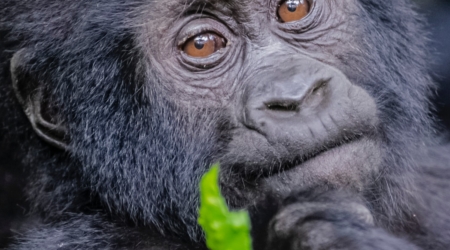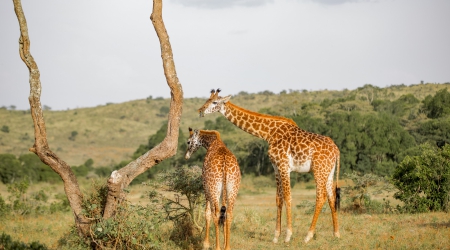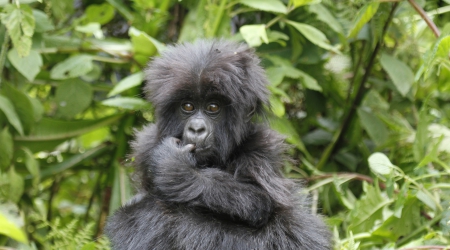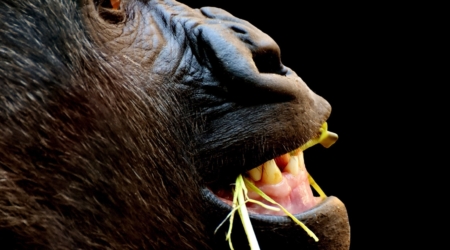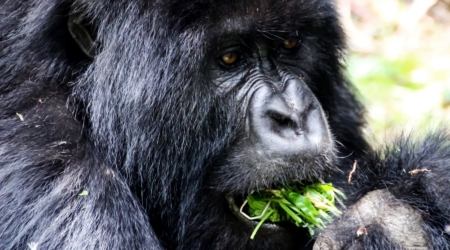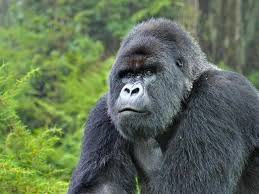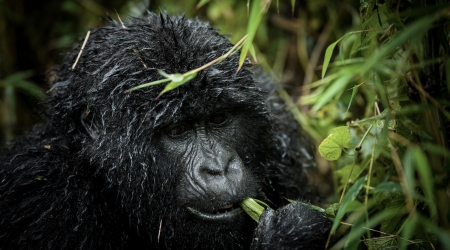Gorilla trekking is a unique, once-in-a-lifetime experience that allows visitors to encounter mountain gorillas in their natural habitat. These trekking excursions offer an up-close view of one of the world’s most critically endangered species. However, unlike traditional safaris, gorilla trekking involves hiking through rugged terrain, often for hours, guided by expert trackers and rangers.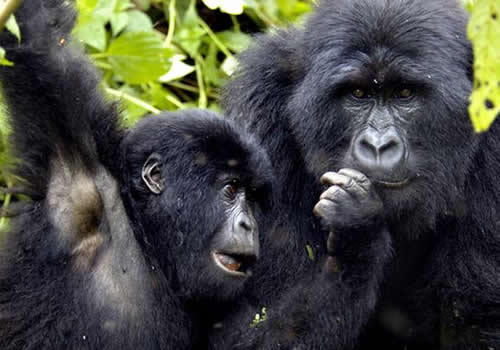
The highlight of the trek is the encounter itself, which is strictly limited to one hour with the gorilla family. This brief window allows visitors a chance to witness the gorillas’ daily activities — from feeding and grooming to playing and nurturing their young. Observing these behaviours in the wild offers a profound understanding of the gorillas’ complex social structures and highlights the conservation efforts needed to protect them.
The one-hour limit may seem short, especially after the long trek through the jungle, but it’s a carefully regulated aspect of gorilla tourism. This restriction serves several critical purposes, primarily centered around the well-being of the gorillas and the conservation of their habitat. To fully appreciate why the encounter is so brief, it’s essential to delve into the guidelines, protections and impacts that define this extraordinary adventure.
Gorilla trekking is governed by strict guidelines designed to protect the gorillas and preserve their delicate habitat. These guidelines are enforced for various reasons, as explained below.
Minimising the human footprint in gorilla habitats
The one-hour rule is part of a larger strategy to minimise the impact of human presence in gorilla habitats. This rule is closely connected to regulating group sizes permitted to visit gorilla families. Only eight visitors can typically spend time with a specific gorilla group daily. By limiting both the duration of the visit and the number of people in each group, conservation authorities can effectively manage the daily human impact within the gorillas’ habitat. Before beginning their trek, visitors receive a briefing on the dos and don’ts of gorilla trekking, including maintaining a minimum distance of about 7 meters (21 feet) from the gorillas to avoid causing distress or disrupting their natural behaviour.
Rangers and trackers play a crucial role in enforcing these guidelines. They lead the trekking groups, typically limited to eight people, and ensure that visitors adhere to the rules throughout the encounter. Limiting group size and time spent with the gorillas is vital to reducing the cumulative impact of daily treks. With multiple groups visiting gorilla families daily, controlling the number of visitors and the duration of the interaction helps protect these animals from excessive human presence.
The one-hour limit is a powerful tool for conservation. It ensures that the gorillas experience minimal disturbance from human activities, allowing them to continue their natural routines while benefiting from the economic support generated by gorilla tourism. This way, the carefully regulated trekking experience balances the desire for human connection with wildlife preservation.
Minimising Stress
Mountain gorillas are highly sensitive to their environment and the presence of humans. Though they have become somewhat habituated to the presence of tourists due to ongoing conservation efforts, they remain wild animals that can experience stress from prolonged human interaction. This stress can manifest in various ways, from changes in behaviour and social dynamics to physical health issues. The one-hour limit on gorilla trekking is primarily designed to minimise this stress, ensuring that the gorillas’ daily lives are not overly disrupted.
Prolonged human presence can interfere with the gorillas’ natural activities, such as foraging, resting, playing, and social bonding. For example, if visitors stay for extended periods, the gorillas might feel compelled to move away or become less active, leading to potential disruptions in their feeding patterns and social interactions. This stress can be particularly harmful to young gorillas, who rely on their mothers and group members to learn essential survival skills.
The one-hour rule helps to mitigate these potential disturbances. Limiting visitors’ time with the gorillas allows the animals to quickly return to their daily routines without significant interference. This brief encounter also reduces the risk of tourists inadvertently displaying behaviors that could be interpreted as threatening or disruptive, such as loud noises, sudden movements, or excessive camera flashes.
Disease Prevention
One crucial reason for the one-hour limit on gorilla trekking is disease prevention. Mountain gorillas share about 98% of their DNA with humans, making them highly susceptible to many of the same illnesses, including respiratory infections, the flu, and even the common cold. Given their critically endangered status, a disease outbreak among a gorilla population can have devastating consequences.
Limiting human contact time is vital in reducing the risk of disease transmission. The one-hour rule minimizes the period when diseases could be transmitted from humans to gorillas. Even with strict guidelines, such as requiring visitors to maintain a distance of at least 7 meters (about 21 feet) and discouraging visits from those who are sick, the risk cannot be eliminated. The shorter interaction time, therefore, acts as an added layer of protection.
Moreover, tourists must wear face masks while interacting with the gorillas to reduce the possibility of airborne disease transmission. The combination of a strict one-hour interaction limit, face masks, and other hygiene protocols creates a safety barrier that helps safeguard the health of these gentle giants.
Conservation authorities understand that the health of the gorilla population is directly linked to their long-term survival. Any illness outbreak could lead to a rapid decline in their already limited numbers. By imposing a one-hour rule, the trekking guidelines prioritise the gorillas’ health, ensuring that tourism can continue to benefit conservation efforts without putting the animals at undue risk.
Limiting interference in the Gorillas’ routine
Mountain gorillas exhibit a complex range of behaviours, from foraging and grooming to playing and social bonding. These activities are essential for physical health, social structure, and emotional well-being. The one-hour time limit during trekking ensures visitors can observe these behaviours naturally without significantly altering the gorillas’ routine or environment.
When humans are present too long, gorillas may change their behaviours out of curiosity or discomfort. They might halt their activities, become more guarded, or even exhibit stress signals, such as vocalising or beating their chests. Such disruptions, if prolonged, could have ripple effects on the gorillas’ social dynamics, feeding patterns, and interaction with each other. Young gorillas, who learn crucial life skills by mimicking adults, are particularly vulnerable to these disruptions.
By restricting the interaction to just one hour, visitors have a snapshot into the lives of these majestic creatures without forcing them to adjust their natural behaviours significantly. This brief period allows tourists to witness various aspects of gorilla life—such as a mother nursing her infant, juveniles playfully tumbling in the grass, or the mighty silverback surveying his family. However, after the hour is up, the gorillas can return to their usual activities without the continued influence of human observers.
Additionally, the limited time frame reinforces a sense of respect and reverence for the gorillas as wild animals rather than a mere attraction. It underscores the importance of observing wildlife responsibly, preserving the gorillas’ natural behaviour for their well-being and the integrity of future research and conservation efforts. By prioritising the maintenance of a natural environment, the one-hour rule ensures that tourists contribute to a sustainable form of wildlife observation that respects the gorillas’ need for space and normalcy.
Conservation purposes
Gorilla trekking is a thrilling adventure for tourists and vital to conservation efforts. The one-hour rule is essential to this conservation-focused tourism model. It carefully balances the desire for a meaningful visitor experience with the imperative to protect the gorillas and their habitat.
Conservation authorities recognise that gorilla tourism generates crucial funding that supports the maintenance of national parks, anti-poaching efforts, habitat restoration, and community development projects. However, minimising its impact on the gorillas is essential to sustain this tourism. The one-hour limit is one way in which this balance is achieved. By controlling the duration of contact, the rule ensures that tourists get an incredible wildlife experience while the gorillas remain undisturbed for most of their day.
Furthermore, the one-hour limit plays a role in managing the overall flow of visitors. Gorilla permits are limited and carefully regulated, with only a certain number of groups allowed to visit a specific family daily. By keeping encounters short, more visitors can have the opportunity to participate in gorilla trekking without overburdening the gorilla population or their habitat. This strategy not only prevents overcrowding but also maximises the economic benefits of tourism, which can then be funnelled back into conservation initiatives.
The result is a win-win scenario: visitors gain an unforgettable educational experience, while the funds raised support the ongoing protection and study of mountain gorillas. The one-hour rule thus reminds visitors that while these encounters are priceless, they are responsible for preserving the gorillas’ natural world. By adhering to this time limit, trekkers become active participants in the conservation mission, helping to secure a future where these magnificent creatures can continue to thrive.
Conclusion: Exploring Gorilla Habituation for Extended Encounters
While the one-hour trekking limit is a standard for most visitors, those seeking a more in-depth experience can participate in a gorilla habituation experience. Gorilla habituation is a unique process wherein wild gorillas are gradually accustomed to human presence over an extended period, making them comfortable enough for regular tourist visits. This process involves researchers, rangers, and a limited number of tourists working together for months or even years to expose a specific gorilla group to humans gently.
During a habituation trek, participants can spend up to four hours with a gorilla family, allowing them to observe they’re natural behaviours more extensively. Visitors witness the gorillas’ daily routines, including foraging, grooming, playing, and social interactions, while learning about the intricate dynamics within the group. This longer interaction time offers an invaluable, immersive educational experience for trekkers and a deeper understanding of gorilla behaviour and conservation efforts.
However, gorilla habituation is a more challenging adventure than standard trekking. It involves trekking to meet a gorilla family that is not yet fully habituated and, therefore, may be more unpredictable and shy around humans. Due to this, habituation treks are conducted in smaller groups with expert guides to ensure both the safety of the visitors and the comfort of the gorillas.
The cost of a gorilla habituation permit is higher than a standard trekking permit, reflecting the added responsibility and the conservation efforts involved in the habituation process. In Uganda, the habituation experience is primarily conducted in Bwindi Impenetrable National Park and requires visitors to follow strict guidelines to minimise the impact on the gorillas’ natural behaviours. This experience not only supports ongoing conservation but also helps foster a deeper connection between humans and these magnificent creatures.
Gorilla habituation is, therefore, an option for those who wish to exceed the one-hour limit while contributing to research and conservation. It provides an extended window into the lives of mountain gorillas, highlighting the importance of their preservation and the delicate balance that must be maintained to keep their habitats thriving. Whether opting for the standard one-hour trek or the more intensive habituation experience, the core focus remains protecting these gentle giants and their way of life.







